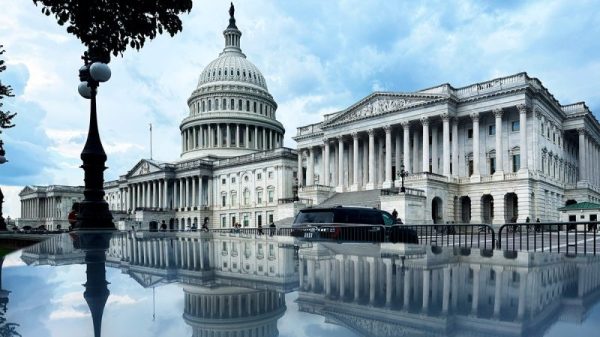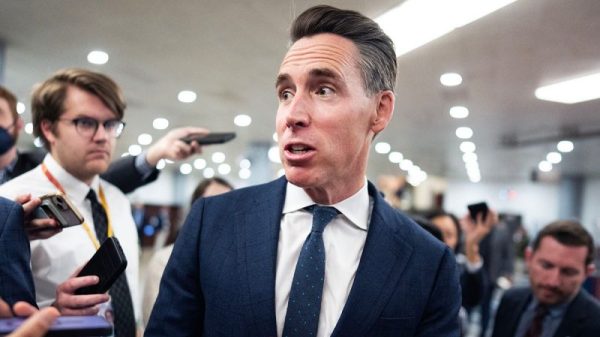Politicians are unquestionably risk-averse. Throughout their careers, they learn certain lessons about electoral politics that are hard to unlearn. This is enormously useful to campaign consultants who can sell candidates on pricey, not-terribly-useful plans of action if similar plans of action have gotten their clients elected in the past. What unwashed socks are to an outfielder on a hitting streak, a certain TV spot might be to a person running for Congress.
Over the past two presidential elections, the winning candidates learned lessons that it seems fair to assume might have colored the way they look at politics. The lesson Donald Trump might have taken away from 2016 is that his assessment that polling was undercounting his support was correct. Joe Biden might have extracted a similar lesson four years later, after a surprisingly poor performance in the first few nominating contests: The result that matters is the one in November.
It’s useful to remember 2020 when considering Biden’s path toward his reelection bid this year. Then, he and his staff took a very even-keeled approach to the nomination and the general election, watching allies and supporters get spun up into a sense of crisis while they simply pressed forward. To some extent, Biden’s team got lucky in the way any candidate might, but either way, the approach worked. Biden won.
So you can understand why Biden’s team might similarly be waiting out this moment of consternation among his allies and other observers. The report on his possession of classified documents from special counsel Robert Hur triggered a new round of analysis about Biden’s age and how perceptions of his age would affect the general election and so on. There has been no shortage of musing about how, hey, maybe Biden could just step aside? Maybe the Democrats could just pretend that the past 10 months or so didn’t happen and start some truncated sort of delegate-assigning process right now with a new slate of candidates? Maybe this could be Trump-vs.-Someone-Else after all?
Prompting the expected response from Biden’s team: no real response at all. Yes, you get the inside-baseball stories about how the State of the Union address will be a reset, but there’s no sign Biden won’t be the Democrat on the ballot in November. Just like Biden kept his head down until the South Carolina primary in 2020 and so on.
This is not as wildly deluded an approach as some seem to think.
First of all, the race remains close. Yes, four years ago, Biden consistently led in national polling at this point and, yes, Democrats needed to win the national vote by a healthy margin to keep the electoral college close in 2016 and 2020. That’s all true. But it is not the case that Biden is obviously losing any of the states he won in 2020. In part, this is because there aren’t a lot of polls yet and, in part, this is because polling this far out isn’t that useful.
Consider polling from March of each presidential year since 1968. Or, to be more accurate, let’s consider the polling averages compiled by 538, a useful assessment of the state of polling in each of those contests. In some cases, we have state-level averages; in some, we don’t. But if we look at the average March two-party margin in states (that is, the difference in support for the Republican and Democrat) and compare it with the actual margin in November, we see that, across about 300 data points, the average difference is seven percentage points. Yes, there’s correlation: States that Republicans win tend to have the Republican up in March. But that’s still a big difference.
That’s the average since 1968. If we look at each year, you can see that the results jump around — and that years with strong independent or third-party candidates tend to see bigger differences.
Polls aren’t designed to predict the results of a contest nine months in the future. They’re not even designed to predict the results of a close contest the next day. People are often far too willing to assume that a poll showing a candidate up by two points was “wrong” if the candidate loses by one point — as though the pollsters didn’t tell people about the margin of error.
Let’s assume, though, that recent polling showing Trump up a point or two nationally is broken-clock-twice-a-day-style exactly predictive of where the race would be in November if nothing else changed. The thing about that is … things will change!
The race isn’t actually set. That’s not to say that Nikki Haley will be the Republican nominee instead of Trump; despite the Haley campaign’s insistence that she might be — and some of the media’s willingness to entertain that idea for the sake of keeping people interested — it will take something other than standard campaign machinations for that to occur. Instead, saying the race isn’t set means that Americans aren’t tuned into the idea that Trump and Biden will once again be facing off in November and/or aren’t paying attention to the race just yet. Democrats’ negative views of Trump have softened in recent months. Will that still be the case after five months of relentless campaign ads?
What’s more, voters’ decisions are historically influenced by things that, in 2024, haven’t yet happened. Research presented in 2012 showed that the presidential popular vote margin was influenced most heavily by income growth in the second quarter of the election year — that is, the quarter that won’t begin until April 1.
Then, of course, there’s the issue of a theoretical replacement. The natural choice would be Vice President Harris, the person Biden himself selected as a successor. Would subjecting her to a primary fight, however short, be better for the party’s chances than keeping Biden in place? Would replacing her? Is there a scenario in which the party dukes it out until and through the convention that doesn’t result in a weaker nominee with less time to gain ground against Trump? All of that aside, there is one Democrat in the mix who has beaten Trump in a national election previously: Joe Biden, the likely nominee.
Things can also get worse for Biden, of course. Whether some manifestation of his age is one of those things, though, is hard to say. Perceptions of Biden’s age are heavily baked into the state of the race at the moment. It might be the case that there are people who might be persuaded not to vote for Biden by some seemingly age-related mistake between now and November, but it seems fair to assume that a lot of those who express concern about his age aren’t likely to change their vote anyway. Particularly since this year, like 2020, is shaping up to be a referendum not on Biden but on Trump.
Now take all of this and overlay the lesson that Biden’s team might have learned in 2020: storms pass. Does that seem like a recipe for Biden to decide now, this late, not to run?
Biden may well lose in November. This learned, perhaps performative sanguinity may not pay off the way it did four years ago. But it seems about as fair to think it might as to assume that it won’t. And that, in a nutshell, is why there’s little reason to think that Biden won’t be the Democratic nominee.
Politicians are unquestionably risk-averse. Throughout their careers, they learn certain lessons about electoral politics that are hard to unlearn. This is enormously useful to campaign consultants who can sell candidates on pricey, not-terribly-useful plans of action if similar plans of action have gotten their clients elected in the past. What unwashed socks are to an outfielder on a hitting streak, a certain TV spot might be to a person running for Congress.
Over the past two presidential elections, the winning candidates learned lessons that it seems fair to assume might have colored the way they look at politics. The lesson Donald Trump might have taken away from 2016 is that his assessment that polling was undercounting his support was correct. Joe Biden might have extracted a similar lesson four years later, after a surprisingly poor performance in the first few nominating contests: The result that matters is the one in November.
It’s useful to remember 2020 when considering Biden’s path toward his reelection bid this year. Then, he and his staff took a very even-keeled approach to the nomination and the general election, watching allies and supporters get spun up into a sense of crisis while they simply pressed forward. To some extent, Biden’s team got lucky in the way any candidate might, but either way, the approach worked. Biden won.
So you can understand why Biden’s team might similarly be waiting out this moment of consternation among his allies and other observers. The report on his possession of classified documents from special counsel Robert Hur triggered a new round of analysis about Biden’s age and how perceptions of his age would affect the general election and so on. There has been no shortage of musing about how, hey, maybe Biden could just step aside? Maybe the Democrats could just pretend that the past 10 months or so didn’t happen and start some truncated sort of delegate-assigning process right now with a new slate of candidates? Maybe this could be Trump-vs.-Someone-Else after all?
Prompting the expected response from Biden’s team: no real response at all. Yes, you get the inside-baseball stories about how the State of the Union address will be a reset, but there’s no sign Biden won’t be the Democrat on the ballot in November. Just like Biden kept his head down until the South Carolina primary in 2020 and so on.
This is not as wildly deluded an approach as some seem to think.
First of all, the race remains close. Yes, four years ago, Biden consistently led in national polling at this point and, yes, Democrats needed to win the national vote by a healthy margin to keep the electoral college close in 2016 and 2020. That’s all true. But it is not the case that Biden is obviously losing any of the states he won in 2020. In part, this is because there aren’t a lot of polls yet and, in part, this is because polling this far out isn’t that useful.
Consider polling from March of each presidential year since 1968. Or, to be more accurate, let’s consider the polling averages compiled by 538, a useful assessment of the state of polling in each of those contests. In some cases, we have state-level averages; in some, we don’t. But if we look at the average March two-party margin in states (that is, the difference in support for the Republican and Democrat) and compare it with the actual margin in November, we see that, across about 300 data points, the average difference is seven percentage points. Yes, there’s correlation: States that Republicans win tend to have the Republican up in March. But that’s still a big difference.
That’s the average since 1968. If we look at each year, you can see that the results jump around — and that years with strong independent or third-party candidates tend to see bigger differences.
Polls aren’t designed to predict the results of a contest nine months in the future. They’re not even designed to predict the results of a close contest the next day. People are often far too willing to assume that a poll showing a candidate up by two points was “wrong” if the candidate loses by one point — as though the pollsters didn’t tell people about the margin of error.
Let’s assume, though, that recent polling showing Trump up a point or two nationally is broken-clock-twice-a-day-style exactly predictive of where the race would be in November if nothing else changed. The thing about that is … things will change!
The race isn’t actually set. That’s not to say that Nikki Haley will be the Republican nominee instead of Trump; despite the Haley campaign’s insistence that she might be — and some of the media’s willingness to entertain that idea for the sake of keeping people interested — it will take something other than standard campaign machinations for that to occur. Instead, saying the race isn’t set means that Americans aren’t tuned into the idea that Trump and Biden will once again be facing off in November and/or aren’t paying attention to the race just yet. Democrats’ negative views of Trump have softened in recent months. Will that still be the case after five months of relentless campaign ads?
What’s more, voters’ decisions are historically influenced by things that, in 2024, haven’t yet happened. Research presented in 2012 showed that the presidential popular vote margin was influenced most heavily by income growth in the second quarter of the election year — that is, the quarter that won’t begin until April 1.
Then, of course, there’s the issue of a theoretical replacement. The natural choice would be Vice President Harris, the person Biden himself selected as a successor. Would subjecting her to a primary fight, however short, be better for the party’s chances than keeping Biden in place? Would replacing her? Is there a scenario in which the party dukes it out until and through the convention that doesn’t result in a weaker nominee with less time to gain ground against Trump? All of that aside, there is one Democrat in the mix who has beaten Trump in a national election previously: Joe Biden, the likely nominee.
Things can also get worse for Biden, of course. Whether some manifestation of his age is one of those things, though, is hard to say. Perceptions of Biden’s age are heavily baked into the state of the race at the moment. It might be the case that there are people who might be persuaded not to vote for Biden by some seemingly age-related mistake between now and November, but it seems fair to assume that a lot of those who express concern about his age aren’t likely to change their vote anyway. Particularly since this year, like 2020, is shaping up to be a referendum not on Biden but on Trump.
Now take all of this and overlay the lesson that Biden’s team might have learned in 2020: storms pass. Does that seem like a recipe for Biden to decide now, this late, not to run?
Biden may well lose in November. This learned, perhaps performative sanguinity may not pay off the way it did four years ago. But it seems about as fair to think it might as to assume that it won’t. And that, in a nutshell, is why there’s little reason to think that Biden won’t be the Democratic nominee.





















